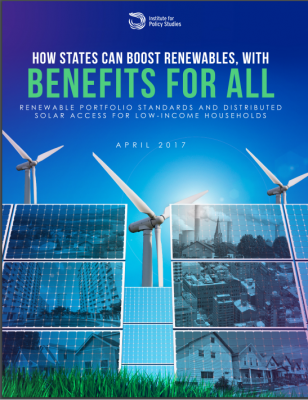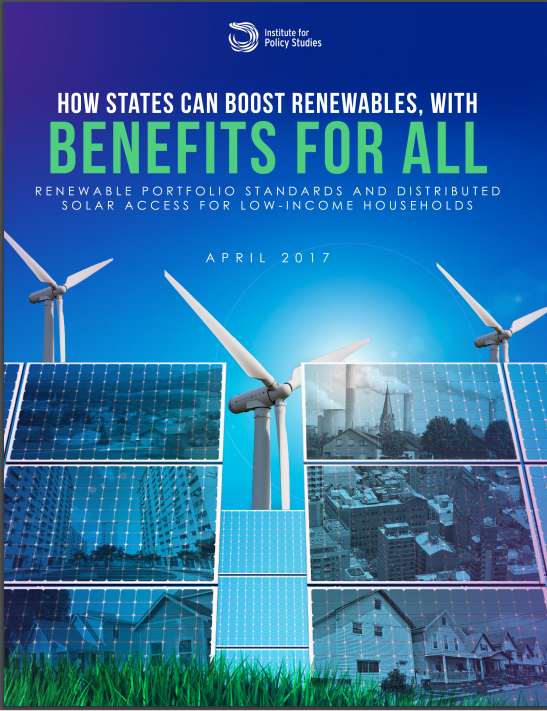 Given the current assault on responsible climate policy at the federal level, innovative state and local actions will be critical if we are to achieve a just transition to a sustainable economy. IPS is surveying the array of measures that can accelerate the rapid transition from fossil fuels to clean and efficient alternatives in an equitable fashion. In this study, we focus in on one strategy: Renewable Portfolio Standards (RPS). RPS require utilities to provide a growing share of electricity from solar and wind energy, and are a particularly promising policy option — especially if they increase the benefits of a clean energy transition for low-income families.
Given the current assault on responsible climate policy at the federal level, innovative state and local actions will be critical if we are to achieve a just transition to a sustainable economy. IPS is surveying the array of measures that can accelerate the rapid transition from fossil fuels to clean and efficient alternatives in an equitable fashion. In this study, we focus in on one strategy: Renewable Portfolio Standards (RPS). RPS require utilities to provide a growing share of electricity from solar and wind energy, and are a particularly promising policy option — especially if they increase the benefits of a clean energy transition for low-income families.
Twenty-nine states and the District of Columbia already have RPS requirements, and eight other states have voluntary renewable energy goals. Building on this progress — by enacting RPS in additional states, tightening current standards, and making voluntary programs binding — would have significant environmental, economic, and social benefits:
KEY FINDINGS:
- RPS expansion can significantly reduce greenhouse gas (GHG) emissions. The electric power generation sector accounts for nearly 30% of total U.S. GHG emissions. Since residential electricity usage currently makes up more than 37% of national utilities sales, RPS success will depend on dramatically expanding home-based solar energy options — especially for low-income households.
- RPS expansion creates good jobs. Solar energy already accounts for nearly 43% of direct U.S. employment in electric power generation, even though it only makes up a tiny fraction of the energy we use to power our country.
- Renewable energy wages are comparable to those in the fossil fuel industry. A typical wind turbine technician, for example, earns $25.50 an hour, significantly more than many fossil fuel occupations.
- Expanding shared solar access advances justice and equity. Low-income communities and communities of color are more likely to live in poorly insulated homes with higher heating and cooling costs, which means they spend more of their income on electricity. A typical set of residential solar panels would meet more than half of an average low-income household’s electricity needs — which means cutting their electricity bill drastically.
- Shared renewables can allow families and small businesses a stake in the renewable energy market. The U.S. electricity market was worth $391 billion in 2015. RPS can help keep more of this money in communities.
Drawing from successful state models, the report identifies the following key “best practice” elements of RPS and low-income solar access policies:
- A sufficiently ambitious timetable.
- No non-renewable or dirty power (nuclear energy, trash incineration, or biofuels) included in “renewables” definition.
- A system of tradable renewable energy credits (RECs) to facilitate tracking.
- Meaningful penalties for noncompliance.
- Requirement to fund solar access for low-income households.
- Incorporating a “green jobs” component into the low-income solar program.
- Legislative provision for shared solar, which also incorporates funding for solar access for low-income communities (#5) and its related targeted hiring and training component (#6).
Read the full executive summary and report here [PDF].
Find sharable graphics and social media kit here.
